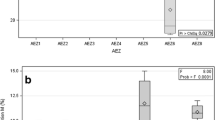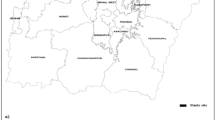Abstract
Community of arbuscular mycorrhizal (AM) fungi in a coastal vegetation on Okinawa island in Japan was examined. A sampling plot was established in a colony of Ipomoea pes-caprae (Convolvulaceae) on the beach in Tamagusuku, Okinawa Pref, in which eight root samples of I. pes-caprae and three root samples each of Vigna marina (Leguminosae) and Paspalum distichum (Poaceae) were collected. Partial 18S rDNA of AM fungi was amplified from the root samples by polymerase chain reaction (PCR) with primers NS31 and AM1. Restriction fragment length polymorphism analysis with HinfI and RsaI for cloned PCR products revealed that two types of Glomus sp., type A and type B, were dominant in the colony. Among them, the fungi of type A were especially dominant near the edge of the colony facing the sea. A phylogenetic analysis showed that the AM fungi of type B are closely related to Glomus intraradices and those of type A are nearly related to type B. From the sequence data, it was also found that type A was further divided into two types, type A1 and A2. One representative strain each of the three types, type A1, A2, and B, propagated from single spore each, was examined for the growth of sorghum (Sorghum bicolor) at three different salinity levels, 0, 100, and 200 mM NaCl. At the non-salt-treated condition, the type B fungus was the most effective on shoot growth enhancement of the host plant, whereas at the salt-treated conditions, the type A2 fungus was the most effective. An efficient suppression of Na+ translocation into the shoot by the examined AM fungi was found. These results suggested that the AM fungi dominant near the sea are adapted to salt-stressed environment to alleviate the salt stress of host plants.



Similar content being viewed by others
References
Al-Karaki GN (2000) Growth of mycorrhizal tomato and mineral acquisition under salt stress. Mycorrhiza 10:51–54
Beena KR, Raviraja NS, Sridhar KR (2000) Seasonal variations of arbuscular mycorrhizal fungal association with Ipomoea pes-caprae of coastal sand dunes, Southern India. J Environ Biol 21:341–347
Brundrett MC, Juniper S (1995) Non-destructive assessment of germination and single-spore isolation of VAM fungi. Soil Biol Biochem 27:85–91
Busse MD, Ellis JR (1985) Vesicular–arbuscular mycorrhizal (Glomus fasciculatum) influence on soybean drought tolerance in high phosphorus soil. Can J Bot 63:2290–2294
Daniell TJ, Husband R, Fitter AH, Young JPW (2001) Molecular diversity of arbuscular mycorrhizal fungi colonising arable crops. FEMS Microbiol Ecol 36:203–209
Davies FT, Potter JR, Linderman RG (1993) Drought resistance of mycorrhizal pepper plants independent of leaf P-concentration-response in gas exchange and water relations. Physiol Plant 87:45–53
Felsenstein J (1985) Confidence limits on phylogenies: an approach using the bootstrap. Evolution 39:783–791
Francis R, Read DJ (1995) Mutualism and antagonism in the mycorrhizal symbiosis, with special reference to effects on plant community structure. Can J Bot 73:S1301–S1309
Gerdemann JW, Nicolson TH (1963) Spores of mycorrhizal Endogone species extracted from soil by wet sieving and decanting. Trans Br Mycol Soc 46:235–244
Giovanetti M, Mosse B (1980) An evaluation of techniques for measuring vesicular–arbuscular infection in roots. New Phytol 84:489–500
Giri B, Mukerji KG (2004) Mycorrhizal inoculant alleviates salt stress in Sesbania aegyptiaca and Sesbania grandiflora under field conditions: evidence for reduced sodium and improved magnesium uptake. Mycorrhiza 14:307–312
Hatimi A (1999) Effect of salinity on the association between root symbionts and Acacia cyanophylla Lind.: growth and nutrition. Plant and Soil 216:93–101
Helgason T, Daniell TJ, Husband R, Fitter AH, Young JPW (1998) Ploughing up the wood wide web. Nature 394:431
Helgason T, Fitter AH, Young JPW (1999) Molecular diversity of arbuscular mycorrhizal fungi colonizing Hyacinthoides nonscripta (bluebell) in a seminatural stand. Mol Ecol 8:659–666
Helgason T, Merryweather JW, Denison J, Wilson P, Young JPW, Fitter AH (2002) Selectivity and functional diversity in arbuscular mycorrhizas of co-occurring fungi and plants from a temperate deciduous woodland. J Ecol 90:371–384
Husband R, Herre EA, Turner SL, Gallery R, Young JPW (2002) Molecular diversity of arbuscular mycorrhizal fungi and patterns of host association over time and space in a tropical forest. Mol Ecol 11:2669–2678
Kimura M (1980) A simple method for estimating evolutionary rates of base substitutions through comparative studies of nucleotide sequences. J Mol Evol 16:111–120
Kitamura S, Murata G, Hori M (1992) Colored illustrations of herbaceous plants of Japan, vol. I (Sympetalae), 65th edn. Hoikusha, Osaka
Kowalchuk GA, De Souza FA, Van Veen JA (2002) Community analysis of arbuscular mycorrhizal fungi associated with Ammophila arenaria in Dutch coastal sand dune. Mol Ecol 11:571–581
Muthukumar T, Udaiyan K (2002) Arbuscular mycorrhizal fungal composition in semi-arid soils of Western Ghats, southern India. Current Science 82:624–628
Nelson CE, Safir GR (1982) Increased drought tolerance of mycorrhizal onion plants caused by improved phosphorus nutrition. Planta 154:407–413
Netondo GW, Onyango JC, Beck E (2004) Sorghum and salinity I. Response of growth, water relations, and ion accumulation to NaCl salinity. Crop Science 44:797–805
Öpik M, Moora M, Liira J, Kõljalg U, Zobel M, Sen R (2003) Divergent arbuscular mycorrhizal fungal communities colonize roots of Pulsatilla spp. In boreal Scots pine forest and grassland soils. New Phytol 160:581–593
Öpik M, Moora M, Liira J, Zobel M (2006) Composition of root-colonizing arbuscular mycorrhizal fungal communities in different ecosystems around the globe. J Ecol 94:778–790
Page RDM (1996) An application to display phylogenetic trees on personal computers. Comp Appl Biosci 12:357–358
Pfeiffer CM, Bloss HE (1988) Growth and nutrition of guayule (Parthenium argentatum) in a saline soil as influenced by vesicular-arbuscular mycorrhizal and phosphorus fertilization. New Phytol 108:315–321
Poss JA, Pond E, Menge JA, Jarrell WM (1985) Effect of salinity on mycorrhizal onion and tomato in soil with and without additional phosphate. Plant and Soil 88:307–319
Ruiz-Lozano JM, Azcon R, Gomez M (1996) Alleviation of salt stress by arbuscular mycorrhizal Glomus species in Lactuca sativa plants. Physiol Plant 98:767–772
Saitou N, Nei M (1987) The neighbor-joining method: a new method for reconstructing phylogenetic trees. Mol Biol Evol 4:406–425
Simon LM, Lalonde TD, Bruns TD (1992) Specific amplification of 18S fungal ribosomal genes from vesicular–arbuscular endomycorrhizal fungi colonising roots. Appl Environ Microbiol 58:291–295
Smith SE, Read DJ (1997) Mycorrhizal symbiosis, 2nd edn. Academic, San Diego
Stahl PD, Smith WK (1984) Effects of different geographic isolates of Glomus on water relations of agropyron smithii. Mycologia 76:261–267
Stutz JC, Copeman R, Martin CA, Morton JB (2000) Pattern of species composition and distribution of arbuscular mycorrhizal fungi in arid regions of southwestern North America and Namibia, Africa. Can J Bot 78:237–245
Subramanian KS, Charest C, Dwyer LM, Hamilton RI (1997) Effect of arbuscular mycorrhizae on leaf water potential, sugar content, and P content during drought and recovery of maize. Can J Bot 75:1582–1591
Sutton JC, Sheppard BR (1976) Aggregation of sand dune soil by endomycorrhizal fungi. Can J Bot 50:1909–1914
Tao L, Zhiwei Z (2005) Arbuscular mycorrhizas in a hot and arid ecosystem in southwest China. Appl Soil Ecol 29:135–141
Thompson JD, Higgins DG, Gibson TJ (1994) Clustal W: improving the sensitivity of progressive multiple sequence alignment through sequencing weighting, position sequence gap penalties and weight matrix choice. Nucleic Acids Res 22:4673–4680
Tian CY, Feng G, Li XL, Zhang FS (2004) Different effects of arbuscular mycorrhizal fungal isolates from saline or non-saline soil on salinity tolerance of plants. Appl Soil Ecol 26:143–148
Turner NC, Kramer PJ (1980) Adaptation of plants to water and high temperature stress. Wiley, NY
Vandenkoornhuyse P, Husband R, Daniell TJ, Watson IJ, Duck JM, Fitter AH, Young JPW (2002) Arbuscular mycorrhizal community composition associated with two plant species in a grassland ecosystem. Mol Ecol 11:1555–1564
van der Heijden MGA, Boller T, Wiemken A, Sanders IR (1998) Different arbuscular mycorrhizal fungal species are potential determinants of plant community structure. Ecology 79:2082–2091
Weising K, Nybom H, Wolff K, Meyer W (1995) DNA fingerprinting in plants and fungi. CRC, Boca Raton
Yamato M, Iwase K (2005) Community analysis of arbuscular mycorrhizal fungi in a warm-temperate deciduous broad-leaved forest and introduction of the fungal community into the seedlings of indigenous woody plants. Mycoscience 46:334–342
Acknowledgements
This study was partly supported by the Ministry of Economy, Trade, and Industry, Japan. We are grateful to Dr. Naohiro Matsui for his instruction on analysis of Na contents in the plant.
Author information
Authors and Affiliations
Corresponding author
Rights and permissions
About this article
Cite this article
Yamato, M., Ikeda, S. & Iwase, K. Community of arbuscular mycorrhizal fungi in a coastal vegetation on Okinawa island and effect of the isolated fungi on growth of sorghum under salt-treated conditions. Mycorrhiza 18, 241–249 (2008). https://doi.org/10.1007/s00572-008-0177-2
Received:
Accepted:
Published:
Issue Date:
DOI: https://doi.org/10.1007/s00572-008-0177-2




